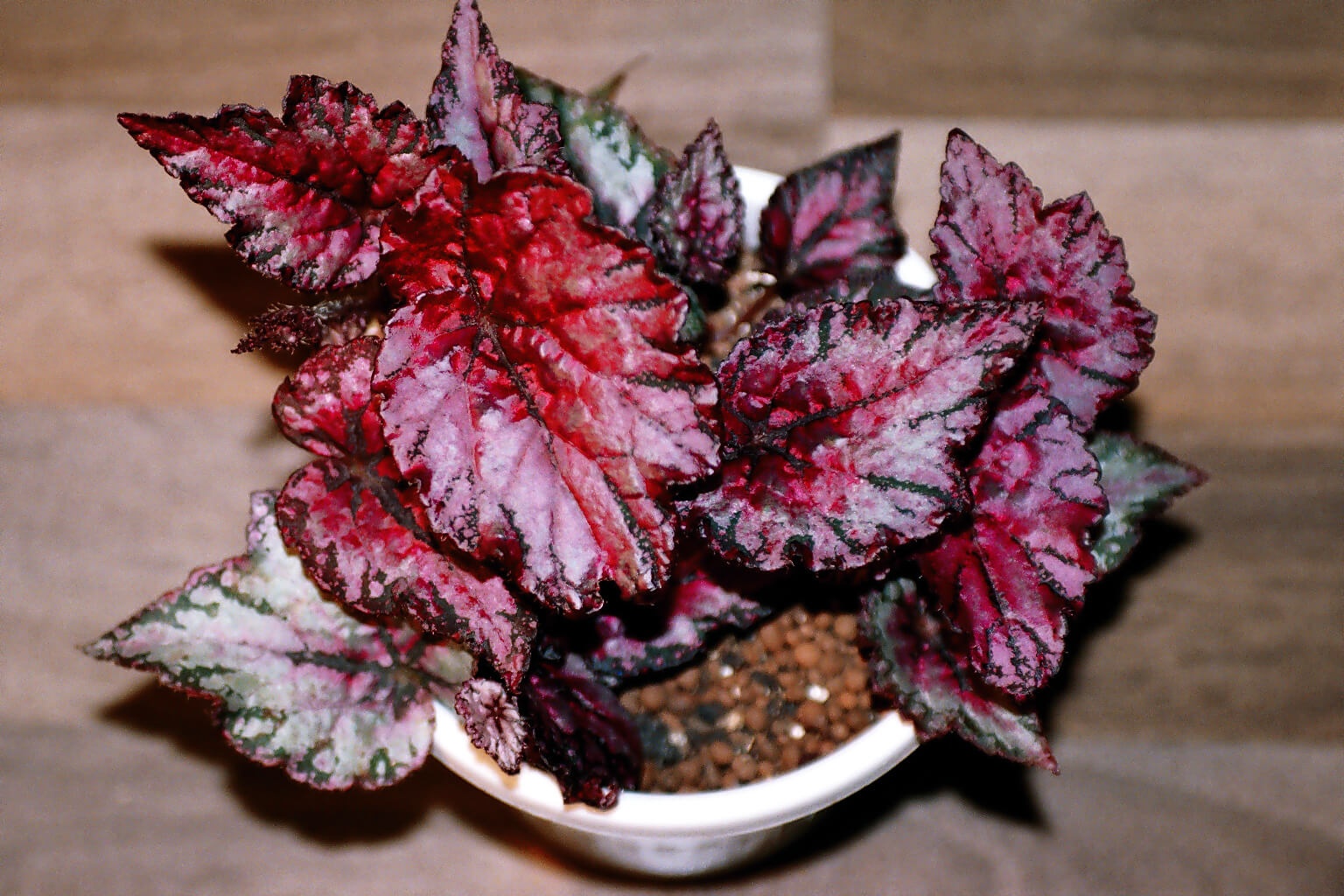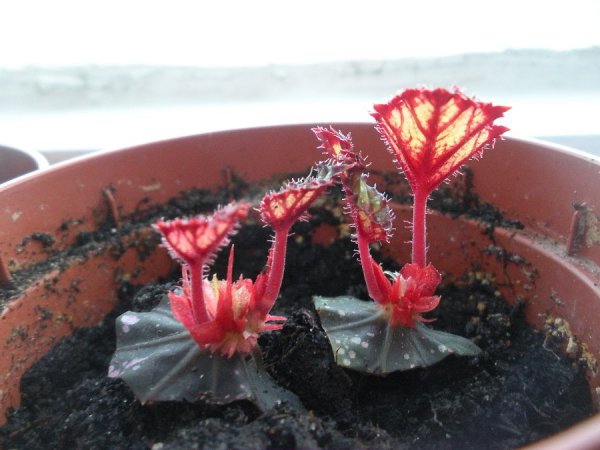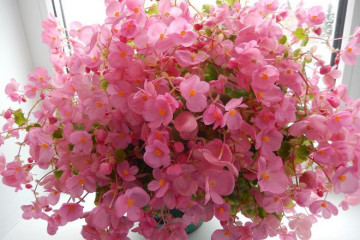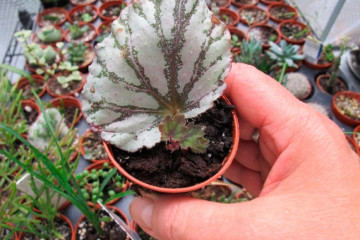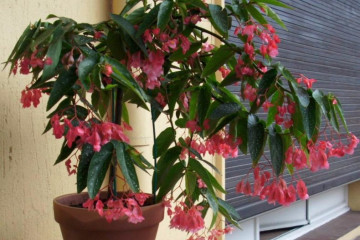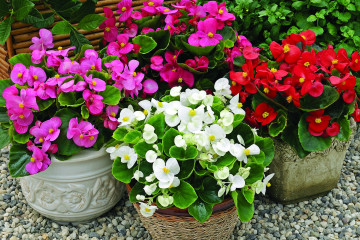Royal begonia (Begonia Rex) at home
Content:
Royal begonia is considered a fairly popular houseplant. The flower is able to decorate any room. Florists especially liked the royal variety, which is often referred to as "pig's ear" and Rex begonia.
Description
The root system of the royal begonia is quite powerful and creeping. The stems of a houseplant, covered with reddish bristles, are fleshy and small in size. Large foliage is asymmetrical. The leaf plates are painted in bright colors:
- green;
- scarlet;
- crimson;
- lilac;
- purple;
- silver.
Veins stand out in contrast. In this, the escargot begonia is similar to her.
Due to the bright coloration of the foliage and its rough surface, the temperature of the sheet plate rises, which provokes the evaporation of a large amount of moisture. The culture is developing rapidly. Against the background of asymmetrical foliage, sunlight is evenly distributed. The diameter of pink flowers barely reaches 1 cm. The flowering period is short. After that, seeds begin to form inside the small fruits.
Planting at home
Royal begonia needs adequate lighting. The foliage should be exposed to diffused sunlight. Begonia Rex can hardly endure hot days. It is important to provide the plant with a room temperature in the range of 25-26 ° C. In the winter months, the temperature regime should not go beyond the boundaries of 16-18 ° C. Recommended humidity level is 48-50%.
Soil preparation
Each planting container must have good drainage holes. A drainage layer is poured into the bottom of the pot. Only then can the container be filled with nutritious soil intended for growing uzambara violets. If you wish, you can independently start preparing the soil mixture at home. To do this, mix:
- leafy ground;
- peat soil;
- coarse river sand;
- a small percentage of coconut substrate;
- pine bark.
Home care
Caring for royal begonia (Begonia - Latin name) is not difficult. It needs systematic moistening of the soil. However, it is necessary to water the flowers only when the top layer of the earth dries out. On hot summer days, it is advisable to spray the green mass.
Top dressing
In the absence of systematic fertilization in the soil, one cannot expect abundant flowering from begonias. Complex feeding is carried out at the end of March. It should include:
- nitrogen;
- phosphorus;
- potassium.
Pruning
Begonias require systematic pruning. This procedure and pinching allow you to achieve:
- lush flowering;
- rejuvenation effect;
- aesthetic appearance.
The rapid growth of decorative culture provokes the rapid pulling of flowers. If you do not prune, begonia will cease to please with flowering, and there will be no trace of lush attractiveness.
As soon as the plant reaches 7 cm in height, you can start the first pruning.The crown can be formed taking into account the own wishes of the owner of the flower. After pruning, the watering frequency is reduced until the active growth period begins. To awaken the lateral buds, experts recommend cutting off the tops of lateral shoots that exceed a height of 10 cm. Dried shoots are removed without regret.
It is recommended to use a sharp knife to carry out pruning yourself at home. To avoid purulent processes and speed up the healing process of slices, it is necessary to treat them with phytosporin or crushed coal.
How to ensure flowering at home
To achieve lush and long-lasting flowering, it is necessary to remove the female inflorescences at the time of bud growth. To distinguish female from male, you need to carefully consider the inflorescences. The largest and most terry are male, and ordinary small inflorescences with three-lobed seed pods are the female variety. Such a trick allows you to achieve a chic flowering of an ornamental culture at home.
When growing royal begonias, some problems may arise, against the background of which the Rex variety ceases to please with flowering or, having collected buds, immediately drops them. Such a situation may arise due to:
- insufficient lighting;
- low level of air humidity;
- unsuitable temperature regime;
- drafts;
- watering with hard water;
- lack of feeding;
- the need to rejuvenate the bush.
By analyzing the conditions for keeping colors, you can determine the error and correct it.
Reproduction
There are several breeding methods that can be used to get new shoots of royal begonia. Reproduction methods and features of their application are presented below.
Tuber division
Before planting begonia tubers in pots, flower growers recommend carefully examining them. If there are eye buds on the tubers, you can start dividing them in order to get new begonia bushes. How to do it:
- Divide tubers of suitable parameters into several parts, using a sharp, sterilized knife for this purpose. At least one bud should remain on each tuber.
- Sprinkle the cuts with crushed charcoal. Dry them.
- Plant the resulting tuber slices in pots filled with nutritious soil. Tubers need to be buried only half.
- As soon as the height of the sprouts that have appeared reaches 6-7 cm, it is necessary to plant the seedlings in larger containers.
Cuttings
The cuttings method can be used for propagation in the spring and autumn months. Perhaps grafting of begonias with stems or foliage.
Stems:
- Cut the stem segments diagonally, the length of which is 6-7 cm.
- The lower part of the segments for 5 min. placed in a jar filled with a small amount of epin or zircon.
- Cuttings are planted in containers filled with a sand-peat mixture.
- The containers are moved to a shaded area. The soil is systematically moistened.
- Rooting of cuttings occurs 5-7 weeks after planting.
- As soon as the roots appear, you can start transplanting the seedlings into separate containers.
Leaves:
- Cut a well-developed, healthy leaf with a petiole across with a sharp knife.
- Dip each tip of the petiole in a solution of epin or zircon.
- The petioles are buried at a slight slope into a light, well-moistened soil. It should be borne in mind that the base of the leaves should not come into contact with the soil surface.
- Leave pots are transferred to a warm and well-lit room. After 14-15 days, roots begin to form at the base of the foliage.
- Transplant each leaf in separate containers filled with moistened soil. Place the pots in a shaded place for a couple of weeks. After a specified period of time, return them to a lighter room.
Seed method
The seed propagation method is ideal when breeding needs to be carried out during the cold season.
- Pour a mixture of leafy earth, peat and river sand into the pots.
- Moisten the soil mixture.
- Spread the seed over the soil surface. It is necessary to slightly press each seed into the ground.
- Cover containers with plantings with foil material.
- Systematically remove the film for airing.
- The first shoots will appear in a couple of weeks. A month later, you can dive the seedlings in separate cups.
What plants are similar to Rex begonia
Begonia Rex vaguely resembles plants by type:
- roses;
- carnations;
- fuchsia;
- violets.
Growing royal begonias is a fun process. An amazing plant is not only endowed with an attractive appearance. Royal begonia is able to purify the air and give people who care for flowers the strength and ability to overcome the most difficult situations.
